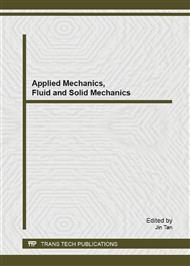[1]
Yang, J. and B.B. Dai, Is the quasi-steady state a real behaviour? A micromechanical perspective. Geotechnique, 2011. 61(2): pp.175-183.
DOI: 10.1680/geot.8.p.129
Google Scholar
[2]
Thornton, C., Numerical simulations of deviatoric shear deformation of granular media. Geotechnique, 2000. 50(1): pp.43-53.
DOI: 10.1680/geot.2000.50.1.43
Google Scholar
[3]
Jiang, M.J., et al., Modeling shear behavior and strain localization in cemented sands by two-dimensional distinct element method analyses. Computers and Geotechnics, 2011. 38(1): pp.14-29.
DOI: 10.1016/j.compgeo.2010.09.001
Google Scholar
[4]
Guo, N. and J. Zhao, The signature of shear-induced anisotropy in granular media. Computers and Geotechnics, 2013. 47(0): pp.1-15.
DOI: 10.1016/j.compgeo.2012.07.002
Google Scholar
[5]
Wang, J. and H. Yan, On the role of particle breakage in the shear failure behavior of granular soils by DEM. International Journal for Numerical and Analytical Methods in Geomechanics, (2011).
DOI: 10.1002/nag.1124
Google Scholar
[6]
Thomas, P.A. and J.D. Bray, Capturing nonspherical shape of granular media with disk clusters. Journal of Geotechnical and Geoenvironmental Engineering, 1999. 125(3): pp.169-178.
DOI: 10.1061/(asce)1090-0241(1999)125:3(169)
Google Scholar
[7]
Sitharam, T., S. Dinesh, and N. Shimizu, Micromechanical modelling of monotonic drained and undrained shear behaviour of granular media using three‐dimensional DEM. International Journal for Numerical and Analytical Methods in Geomechanics, 2002. 26(12): pp.1167-1189.
DOI: 10.1002/nag.240
Google Scholar
[8]
O'Sullivan, C., Particle-Based Discrete Element Modeling: Geomechanics Perspective. International Journal of Geomechanics, 2011a. 11(6): pp.449-464.
DOI: 10.1061/(asce)gm.1943-5622.0000024
Google Scholar
[9]
Yan, W.M. and L. Zhang, Fabric and the critical state of idealized granular assemblages subject to biaxial shear. Computers and Geotechnics, 2013. 49: pp.43-52.
DOI: 10.1016/j.compgeo.2012.10.015
Google Scholar
[10]
Pena, A.A., et al., Biaxial test simulations using a packing of polygonal particles. International Journal for Numerical and Analytical Methods in Geomechanics, 2008. 32(2): pp.143-160.
DOI: 10.1002/nag.618
Google Scholar
[11]
Belheine, N., et al., Numerical simulation of drained triaxial test using 3D discrete element modeling. Computers and Geotechnics, 2009. 36(1-2): pp.320-331.
DOI: 10.1016/j.compgeo.2008.02.003
Google Scholar
[12]
Oda, M., S. Nemat-Nasser, and J. Konishi, Stress-induced anisotropy in granular masses. Soils Found, 1985. 25(3): pp.85-97.
DOI: 10.3208/sandf1972.25.3_85
Google Scholar
[13]
Wang, J., J. Dove, and M. Gutierrez, Discrete-continuum analysis of shear banding in the direct shear test. Geotechnique, 2007. 57(6): pp.513-526.
DOI: 10.1680/geot.2007.57.6.513
Google Scholar
[14]
Zhou, B., et al., DEM investigation of particle anti-rotation effects on the micromechanical response of granular materials. Granular Matter, 2013. 15(3): pp.315-326.
DOI: 10.1007/s10035-013-0409-9
Google Scholar
[15]
Wang, Y. and S. Leung, Characterization of cemented sand by experimental and numerical investigations. Journal of Geotechnical and Geoenvironmental Engineering, 2008. 134(7): pp.992-1004.
DOI: 10.1061/(asce)1090-0241(2008)134:7(992)
Google Scholar
[16]
Abbireddy, C.O.R. and C.R.I. Clayton, Varying initial void ratios for DEM simulations. Geotechnique, 2010. 60(6): pp.497-502.
DOI: 10.1680/geot.2010.60.6.497
Google Scholar
[17]
Itasca, PFC2D Particle Flow Code: User's Manual, Inc., Minnesoata, USA. (2008).
Google Scholar
[18]
Cheng, Y.M., et al., Flow Pattern for a Silo with Two Layers of Materials with Single or Double Openings. Journal of Geotechnical and Geoenvironmental Engineering, 2010. 136(9): pp.1278-1286.
DOI: 10.1061/(asce)gt.1943-5606.0000334
Google Scholar


